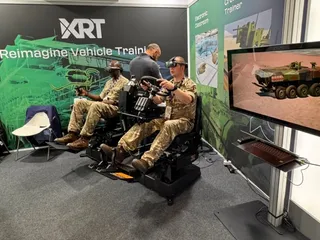Beyond Protecting the Flight Deck
Contact Our Team
For more information about how Halldale can add value to your marketing and promotional campaigns or to discuss event exhibitor and sponsorship opportunities, contact our team to find out more
The Americas -
holly.foster@halldale.com
Rest of World -
jeremy@halldale.com

Group editor Marty Kauchak highlights developments in the training programs designed to prepare federal air marshals and flight attendants to maintain a secure flight cabin environment.
The flight cabin remains a dynamic, challenging security environment. The lack of civility in our society has migrated onto commercial aircraft, where incidents of unruly and boorish behavior on domestic and international flights make headlines with increasing frequency. And while agile and adaptive terrorists devise new strategies to destroy aircraft in flight, personnel responsible for onboard security must concurrently enforce well-intended, but perhaps short-sighted directives governing passengers. Indeed, as this article was written, John S. Pistole, the Administrator of the US Transportation Security Administration (TSA), made the decision to start allowing a number of items in carry-on bags beginning this April 25th, including small pocket knives with non-locking blades smaller than 2.36 inches (59.9 mm) and less than 1/2 inch in width, small novelty baseball bats and toy bats, ski poles, hockey sticks, lacrosse sticks and the like. So never mind these new items will have to be stored in already congested overhead storage bins. Federal air marshals (FAMs) and flight attendants who are vital in establishing and maintaining cabin security, must now be attentive to the presence of this new materiel in their operational domain.
One Assessment
There is a common consensus inside the Washington, D.C. Beltway that while there has been an improvement in commercial airline security since 9/11, all of the community’s stakeholders need to pay attention and respond to the evolving threat environment.
One community insider provided her thoughts on how training has been a foundation of the post-9/11 success, but parsed no words when speaking about the challenges needed to maintain security excellence.
Candace Kolander, the Air, Safety, Health & Security Coordinator for the Association of Flight Attendants (AFA) – CWA, pointed out that since 9/11, cabin security training has dramatically evolved and improved. The contemporary security training philosophy for the flight attendants’ community, developed during the frenetic months following the attacks of September 11, remains focused on protecting the flight deck. Of particular interest, there has not been an industry-wide review of that training construct since it was introduced last decade. Indeed, during Kolander’s discussion with CAT this February, the Washington, D.C.-based union representative also noted “the Association of Flight Attendants believes we are now running the risk of becoming complacent when we talk about security.”
The AFA has further observed four major trends which challenge the current security training model and provide a compelling reason for industry stakeholders to conduct a task force-level review of cabin security protocols. At the top of the AFA’s list of developments were: reissuing a call for new carry-on luggage guidelines; restricting select communication systems used by passengers; and deploying wireless communication system among the cabin crew. “We also need better hands-on counter-terrorist training,” Kolander emphasized.
The improved training envisioned by AFA would include more rigorous situational exercises and other strategies to help flight attendants better respond to more diverse security scenarios.
Kolander cited the existing, one-day crew member self-defense training (CMSDT) course as having the potential to be adapted for flight attendant use. “If we really wanted to be progressive, you could almost take a similar type of training like that and move it into the flight attendant required training program,” she remarked. And while the CMSDT course is voluntary, its content includes cognitive recognition of terrorists, stress inoculation (teaching how to deal with an aggressive situation) and related topics which place the learner in hands-on, situational environments. “We would like to see a similar type program, but even more aggressive than that, in our recurrent training,” Kolander said.
Specific Developments
The FAMs and flight attendants complete rigorous and comprehensive, accession and refresher training to prepare them to operate in the dynamic domain outlined by Kolander. When possible, technology is used to bolster the fidelity of these courses.
The Federal Air Marshall community has increased the quality and scope of training through its continuum of learning to better prepare its members for their onboard duties.
The marshals receive approximately 16 weeks of intense training upon being hired, and complete 40 hours of regular, recurrent training every quarter throughout their careers.
Kimberley Thompson, the Assistant Supervisory Air Marshal in Charge in the Office of the Director, Office of Law Enforcement/Federal Air Marshal Service at TSA, told CAT the Federal Air Marshal Candidates now receive the first portion of training at the Federal Law Enforcement Training Center in Artesia, New Mexico. “This training focuses on the basic law enforcement skills required of any law enforcement officer; basic firearms, handcuffing, defensive measures, laws and regulations, as well as report writing and interviewing skills,” she said.
Candidates then receive the final portion of their training at the Federal Air Marshal Service Training Center, in Atlantic City, New Jersey. The center is situated on the grounds of the FAA Technical Center and has a main office space and classroom building, as well as two outdoor ranges, three indoor/outdoor 50-yard line ranges, a tactical multipurpose training facility, and several realistic aircraft simulators, Thompson explained.
Given the rules of engagement and other operating parameters for marshals, it should come as no surprise that the Federal Air Marshal Service maintains the highest firearms standard of any federal law enforcement organization. FAMs must qualify quarterly with an 85 percent or better score. “During the final portion of training, candidates will learn the specifics of special aircraft jurisdiction, international aviation treaties, and advanced firearms and defensive measures,” Thompson said, and continued, “Their training culminates in realistic scenarios designed to test their knowledge, physical skills, and decision making ability on board aircraft and in other transportation domains. Upon graduation, the FAMs return to their assigned field offices and begin flying domestic and international missions.”
Airline Perspective
Mirroring the strategy at other carriers, JetBlue’s Inflight crewmembers (the company’s title for its flight attendants) receive security training during their initial qualification as well as during their required annual recurrent training to respond to a variety of security issues. Thomas Kaminski, JetBlue’s Manager for Inflight Training, pointed out the carrier’s training philosophy is to introduce knowledge and awareness, develop skills, practice tasks, and then practice and evaluate events in Line Oriented Flight Training environment.
Kaminski provided further insights on the foundation of JetBlue’s efforts in this area, noting the most effective security program is proactive, and a pivotal part of security training is an understanding of the current environment. As a result, “Our security training is developed in tandem with our Corporate Security team. This partnership allows us to adjust our crew training as needed to remain relevant and nimble. Specific techniques are a matter of security and as such we cannot share,” Kaminski commented.
Whereas carriers outsource many administrative and maintenance tasks, JetBlue has retained oversight and responsibility for security learning content, with all operational training at JetBlue completed by its corporate learning department, JetBlue University, based in Orlando.
And replicating the trend for more interagency and government-industry training found in the US Defense Department and other government organizations, JetBlue has similarly expanded its security training audiences – when it is possible and appropriate. “For example, Federal Air Marshalls regularly attend our new-hire training, and our recurrent training is conducted jointly with our pilots whenever possible,” Kaminski said.
The JetBlue training official noted that when FAMs participate in the carrier’s classes, Inflight crewmembers are afforded the opportunity ask operational questions and observe demonstrations of the marshals responding to different in-flight scenarios.
Opportunities
The Federal Air Marshal Service uses aircraft simulators for the purpose of conducting scenario based training at the training center and at each of its field office locations. “These simulators enable us to provide a realistic environment for our workforce,” Thompson emphasized.
Over at JetBlue, the carrier uses a “blended approach” to its learning, making use of computer-based training, instructor-led training, individual skill practice, and crew scenario practice.
Beyond CBT, Kaminiski said, “We're always exploring new and improved ways to leverage emerging technologies for training. We have discussed the possibility of using computer assisted simulation similar to gaming, but we aren't there yet. We are also thinking about ways to use tablet devices as learning tools.”


